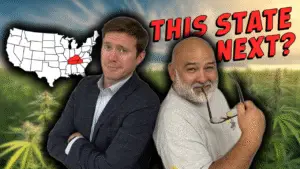By Staff Writer
September 21, 2025
Cannabis policy watchers are staring down another season of hurry-up-and-wait. On the latest episode of Cannabis Legalization News, hosts took stock of a strangely quiet stretch in U.S. reform—punctuated by congressional gridlock, state-level enforcement whiplash, and an eye-opening look at the United Kingdom’s under-the-radar medical program.
Federal fog: rescheduling drifts, appropriations collide with holidays
Three years after President Biden directed a review of marijuana’s federal status (October 2022), the long-promised move to Schedule III remains mired in administrative procedure and leadership churn at the Drug Enforcement Administration. An evidentiary hearing is underway, but as the hosts emphasized, the presiding administrative law judge only issues a recommendation; DEA leadership can accept it—or ignore it. “They’ve ignored ALJ findings before,” one noted, recalling 1980s-era decisions critical of Schedule I that never changed policy.
Complicating the calendar: Rosh Hashanah begins at sundown Monday and Yom Kippur follows roughly 10 days later, while Congress faces a September 30 fiscal year deadline. With both chambers largely out, riders that could either hobble or hard-stop rescheduling—along with hemp-related measures—may simply slide. The upshot: don’t expect meaningful movement until October at the earliest, and even that’s optimistic.
A prohibitionist hearing—and a missed policy opportunity
The week’s marquee federal storyline was a House oversight hearing nominally about Chinese transnational criminal organizations (TCOs) laundering money through cannabis operations, with repeated references to Maine and Oklahoma. Witnesses, the hosts said, were uniformly prohibitionist; lawmakers pushing the idea that criminality thrives because cannabis remains illegal found little traction.
For reform advocates, it was a missed chance: a national framework tied to Schedule III could set minimum compliance standards and reduce the regulatory arbitrage fueling bad actors in loosely regulated states. Instead, the hearing reinforced a familiar Washington pattern—headline-ready fear without legislative follow-through.
Oklahoma isn’t what it was—yet reputations linger
One co-host pushed back on the idea that Oklahoma remains a regulatory free-for-all. Early laxity (including residency quirks and a flood of licenses) created massive oversupply, but subsequent crackdowns tightened rules and closed the front door for newcomers. The reputational lag remains, however, and with thousands of licenses still on the books, enforcement struggles to keep pace.
By contrast, heavily regulated markets like Illinois and Missouri haven’t drawn similar TCO narratives. The thread tying it together: you can’t prevent crime with headlines; you need coherent rules, enforced predictably.
Illinois: permits, hemp headwinds, and the super social equity stall
On the ground, the show offered a candid snapshot of Illinois’ growing pains. One host described a now-familiar permitting slog—architectural drawings, mechanical/electrical/plumbing plans, and city timelines that stretch weeks into months—while builders eye other jobs. It’s the unglamorous reality of legalization: customers only see ribbon cuttings, not the ulcers along the way.
Two structural problems dominate Illinois’ next chapter:
-
Social equity inertia. Many “super social equity” dispensary licenses remain unopened—financing is scarce, build-outs are expensive, and the competition now includes liquor stores that openly cross-sell hemp intoxicants (“Want a six-pack? How about gummies?”). Litigation around at least one social-equity client may drag into 2026.
-
Hemp loopholes. With zero statewide guardrails, intoxicating hemp products can outflank licensed cannabis—no age gates, no potency caps, no track-and-trace. The hosts floated the possibility of executive action from the Governor, potentially in tandem with a long-awaited state loan program, to protect licensed operators and public safety. Whether that lands before year-end is anyone’s guess.
Illinois’ legal contradictions remain surreal: the smell of burnt cannabis is not probable cause for a vehicle search; the smell of raw cannabis can be—despite legal hemp flower being indistinguishable by scent.
Culture war reruns—and an employment reality
The hearing chatter about “protecting kids” collided with an inconvenient truth: unregulated intoxicating hemp is easier for minors to access than licensed cannabis. Meanwhile, national advocacy groups still attract federal microphones to warn about youth use, even as adult-use legalization hits two dozen states and medical programs top 40.
The show made a pragmatic point often missed in online debates: until laws change, workers can still lose jobs over cannabis. “Deschedule” is a slogan; employment protections require statutes and policies, not vibes.
Across the pond: the U.K.’s tiny medical market imports its flower
For an international gut check, the hosts welcomed Dave Barton from near Bristol to unpack the U.K.’s medical cannabis reality:
-
Patient count: About 60,000 active patients in a country of 67 million—a rounding error compared with U.S. medical participation.
-
Since when? Legal since November 2018, catalyzed by pediatric epilepsy cases and the drug Epidiolex. General practitioners can’t simply prescribe; specialist oversight is required.
-
Where’s the weed from? Much of the U.K.’s medical flower is imported—often Canada, Southern Europe (e.g., North Macedonia, Portugal), and Australia—with a growing but still small domestic cultivation base. Pharmacies and clinics are typically separate entities; Good Manufacturing Practice (GMP) standards apply.
-
Stigma and policing: Awareness is low, stigma is high, and patients are advised to carry prescriptions and original containers to avoid police hassles. Local councils have started carving out public-consumption allowances for patients, but nationwide decriminalization remains a political long shot.
-
Economics: Private-clinic consults and flower costs put legal access out of reach for many fixed-income patients, feeding a large self-medicating illicit market. Barton’s blunt assessment: the near-term priority should be expanding the patient base to lower costs and normalize care.
The U.K.’s classification toggled from Class C back to Class B years ago, signaling politics over public health. London’s mayor has mused about decriminalization, but national change will likely be slow—“eight to ten years,” Barton estimated, for any true adult-use framework.
Edibles vs. inhalables—and the knowledge gap
The conversation revisited an evergreen consumer safety point: oral cannabis (edibles, tinctures) metabolizes differently than inhaled products. Overconsumption stories typically start with “I didn’t feel anything… so I took more.” In regulated markets, budtender education helps; in the U.K., doctors and pharmacists are still doing “Cannabis 101.” Until product literacy becomes boringly mainstream, preventable bad experiences will keep making news.
The road ahead: policy by attrition
If this week felt anticlimactic, it’s because cannabis policy in 2025 is dominated by absences—hearings without legislation, calendars without quorum, and markets without coherent hemp rules. The DEA can resolve rescheduling, but history says not to bet the farm on administrative courage. States can fix hemp loopholes, but only if governors and legislatures act. The U.K. can scale patient access, but only with sustained political will and healthcare buy-in.
The line the show kept circling: legalization is logistics. Permits, financing, supply chains, training, compliance. That’s how you get beyond headlines and into the mundane miracle of a working market. Until then, expect more smoke than fire—and, for many lawful operators, more ulcers than ribbon cuttings.
Shanah Tovah to those observing. Congress will be, predictably, observing too.



